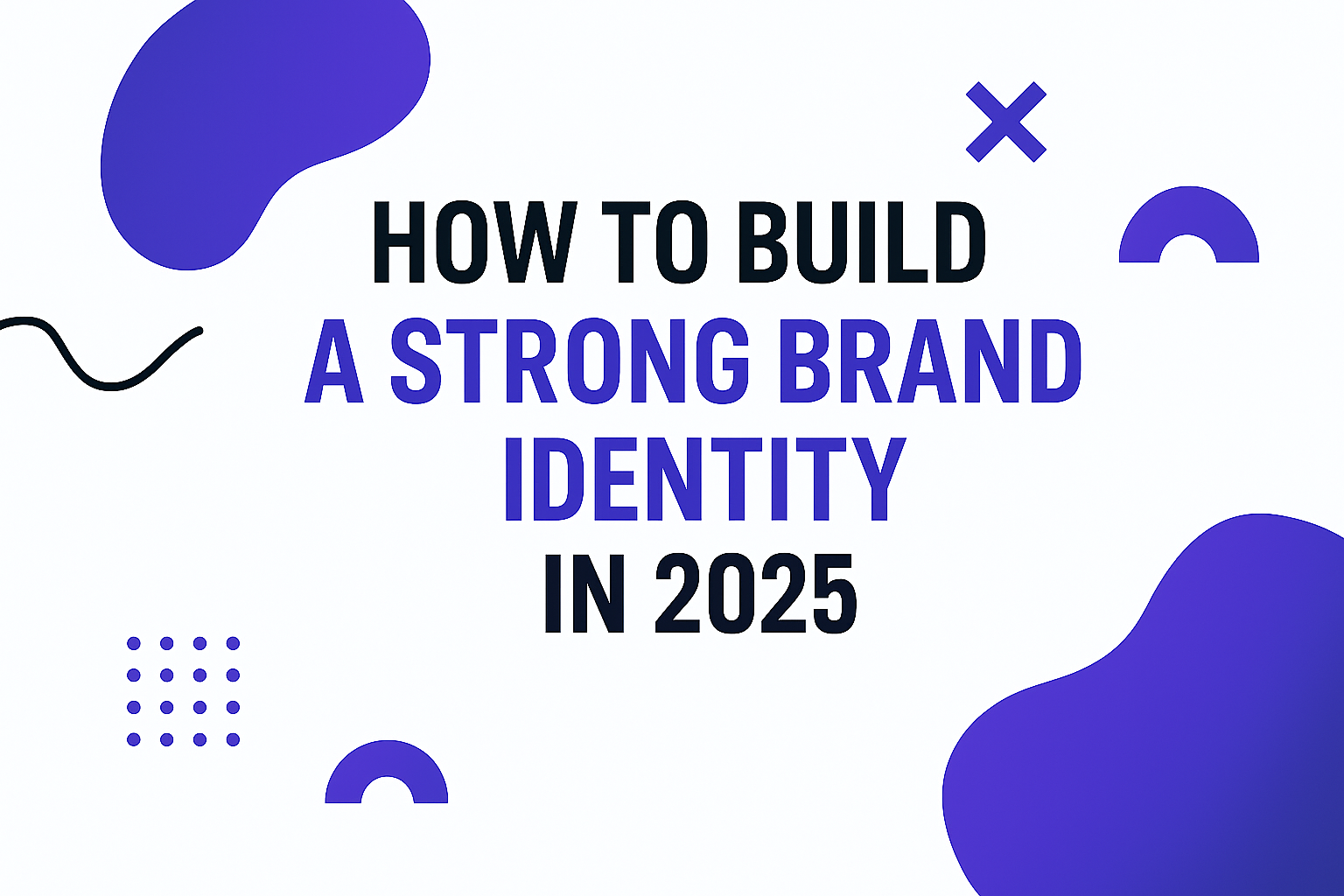Introduction
In today’s competitive business environment, a strong brand identity is not just a logo — it’s a complete experience. Your brand is how people feel about your company, what they remember about you, and why they choose you over others. In 2025, building a recognizable and trusted brand is more important than ever.
The modern customer doesn’t just buy products; they buy purpose, values, and stories. Whether you’re a startup or a growing business, brand identity shapes how the world perceives you. It influences your marketing, communication, and even your internal culture.
This article will guide you through every essential element of building a lasting brand identity — from visuals and storytelling to emotional connection and consistency — so that your brand doesn’t just exist but truly leaves a mark.
Logo & Colors
Your logo and color palette are the visual foundation of your brand identity. These are often the first things customers notice — and first impressions matter.
A great logo is simple, memorable, and meaningful. It should represent your brand’s values and personality. In 2025, brands are leaning toward minimalistic and adaptive logo designs that work across all platforms from websites to app icons and social media.
When it comes to colors, consistency is key. Different colors trigger different emotions:
- Blue conveys trust and professionalism.
- Red shows energy, excitement, and passion.
- Green suggests growth, health, and sustainability.
Choose colors that reflect your mission and tone. Once selected, use them consistently across all materials — your website, packaging, posts, and marketing assets. The goal is for people to instantly recognize your brand even without seeing its name.
Brand Voice
Your brand’s voice is how it speaks to the world. It’s the tone, language, and attitude you use across all communications. A strong brand voice helps you connect emotionally and build familiarity with your audience.
To define your voice, start by identifying your target audience. Are they professionals, youth, families, or creators? Your tone should match their expectations and preferences.
For example:
- A financial consultancy might use a formal, reassuring voice.
- A lifestyle brand might use a friendly, conversational tone.
- A tech startup might sound innovative and confident.
Once you decide on your tone, apply it everywhere in emails, ads, blogs, and customer support. A consistent voice strengthens brand personality and ensures people recognize you even through your words.
Customer Trust
In 2025, trust is the ultimate currency in branding. Customers no longer rely solely on ads — they look for authenticity, transparency, and credibility.
Building trust takes time but pays off immensely. Here’s how you can nurture it:
- Deliver on Promises: Never overpromise or mislead in advertising.
- Be Transparent: Share your business journey, processes, and even your challenges.
- Show Real People: Use authentic testimonials, case studies, and team highlights.
Brands that stay honest and transparent are the ones people come back to. In fact, studies show customers are more likely to remain loyal to brands they perceive as honest, even if a competitor offers a cheaper product.
Trust builds loyalty, and loyalty builds lasting businesses.
Social Presence
Social media is no longer just a marketing tool — it’s an identity builder. Your social media platforms are the digital storefronts of your brand. In 2025, strong social presence isn’t about posting daily but about posting meaningfully.
Focus on platforms where your target audience spends time. Instead of spreading yourself thin, master a few key spaces. For example, Instagram works well for lifestyle and visual brands, LinkedIn for B2B companies, and TikTok for creative, youth-driven audiences.
Engage through storytelling, live sessions, and user-generated content. Share not just your products but your purpose — what your brand stands for.
Social media also acts as your real-time reputation manager. Quick replies, polite responses, and active engagement show customers that your brand is alive, approachable, and caring.
Storytelling
People don’t remember facts; they remember stories. That’s why storytelling has become one of the most powerful brand-building strategies.
A brand story defines why you exist and who you exist for. It’s not about your company history — it’s about the emotional connection you build with your audience.
Your story should answer three key questions:
- What inspired your brand to start?
- What problem are you solving?
- How does your product improve people’s lives?
For instance, a clothing brand might share its commitment to sustainability through the story of how it sources materials ethically. Or a digital platform might share how it empowers freelancers to find meaningful work.
Strong storytelling transforms a business into a cause people believe in. It gives customers a reason to stay connected not just for what you sell, but for what you stand for.
Consistency
Consistency is the thread that ties your brand identity together. Without it, even great visuals or messaging lose impact. Every element — from your website layout to social media posts and customer interactions should feel like part of the same brand experience.
Brands that maintain visual and tonal consistency are remembered longer and trusted more. When customers see your colors, logo, or communication style repeatedly, they subconsciously associate them with reliability and professionalism.
Consistency also improves efficiency. When your design and tone are standardized, creating new campaigns becomes easier, faster, and more effective.
To achieve consistency:
- Use brand guidelines that cover logo use, color codes, fonts, and tone.
- Train your team to follow these guidelines across all platforms.
In the digital era, where consumers encounter hundreds of brands daily, consistency ensures yours stands out and feels familiar every single time.
Emotional Connection
A brand that makes people feel something will always outperform one that just sells something. Emotional branding focuses on creating feelings of trust, joy, hope, or belonging around your brand.
For example, Apple inspires creativity, Nike motivates action, and Coca-Cola associates itself with happiness. None of these emotions are about the product itself — they’re about what the brand means.
To build emotional connection, understand your audience deeply — their fears, dreams, and values. Show empathy through your messaging, visuals, and customer service. Celebrate their milestones, appreciate their loyalty, and make them feel seen.
A brand with emotional depth turns buyers into advocates people who don’t just purchase but proudly recommend you to others.
Adaptability
In 2025, change is constant. Brands that stay rigid risk becoming irrelevant. A strong identity doesn’t mean never changing; it means evolving while staying true to your core values.
Adaptability involves updating your visuals, tone, or marketing approach to match new trends and technologies. For example, many brands now incorporate AI-driven customer experiences, sustainable product design, and inclusive messaging to stay relevant.
When adapting, always ask: “Does this change reflect our brand’s purpose?” If the answer is yes, evolve confidently.
Flexibility keeps your brand modern, while your core identity keeps it authentic. The balance between the two defines lasting success.
Community Building
The strongest brands don’t just attract customers — they create communities. In 2025, audiences crave connection and shared experiences. By building a brand community, you transform one-time buyers into long-term supporters.
Communities can exist on social media groups, online forums, or even within your website. Encourage users to share feedback, experiences, and ideas.
Hosting webinars, loyalty programs, and exclusive member events adds value and fosters belonging. When people feel part of your brand journey, they help promote it naturally.
A community-driven brand grows organically because its customers become its voice.
Conclusion
Building a strong brand identity in 2025 means balancing creativity with consistency, emotion with logic, and authenticity with adaptability. It’s about more than just marketing — it’s about creating meaning.
Your brand should reflect who you are, what you stand for, and how you serve your audience. From your logo to your storytelling and customer relationships, every touchpoint must communicate the same core message: trust, purpose, and value.
In a digital world overflowing with options, brands that connect emotionally and stay true to their vision are the ones that endure. So, invest time in your identity — because your brand isn’t just what people see, it’s what they remember, believe in, and share with others.


